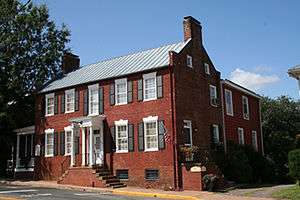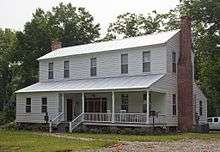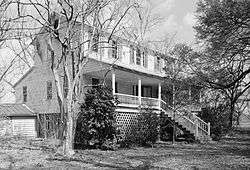I-house
The I-house is a vernacular house type, popular in the United States from the colonial period onward. The I-house was so named in the 1930s by Fred Kniffen, a cultural geographer at Louisiana State University who was a specialist in folk architecture. He identified and analyzed the type in his 1936 study of Louisiana house types.[1][2][3] He chose the name "I-house" because of its common occurrence in the rural farm areas of Indiana, Illinois and Iowa, all states beginning with the letter "I".[4] He did not use the term to imply that this house type originated in, or was restricted to, those three states.[1] It is also referred to as Plantation Plain style.


History and defining characteristics


The I-house developed from traditional 17th century British folk house types, such as the hall and parlor house and central-passage house. It became a popular house form in the Mid-Atlantic and Southern United States at an early date,[5] but can be found throughout most of the country in areas that were settled by the mid-19th century, especially through the culturally mixed midland, an area through central Pennsylvania and roughly paralleling Interstate 70 through Ohio, Indiana and Illinois (or approximate to the old National Road). I-houses generally feature gables to the side and are at least two rooms in length, one room deep, and two full stories in height.[5] They also often have a rear wing or ell for a kitchen or additional space. The facade of an I-house tends to be symmetrical, and they were constructed in a variety of materials, including logs, wood frame, brick or stone.
In his book on folk architecture in north-central Missouri, Marshall devotes nine pages to the I-house after investigation of close to 100 old houses in “Little Dixie.”[6] He calls the I-house the “Farmer’s Mansion.” It is the Southern style house sought by a middle class planter, a symbol of his success. (DW Meinig introduces the I-house and the dogtrot as symbols of Southern influence in his Shaping of America.)[7] In Little Dixie, settlers were so eager to build an I-house that many lived in tents until the I-house was completed.
Marshall classifies folk houses by type using rules developed by Henry Glassie.[8] The basic unit is a sixteen by sixteen foot “hall” called a pen. A single pen house might be a typical log cabin. Combinations define other types. A two story single pen house is known as a stack house. Pens can also be extended side by side to create a two-pen house, which with a central hall becomes a dogtrot. A two story two-pen house is the basic I-house. The house may by modified by additions, but the pen system provides a classification.
These nineteenth century houses lack indoor plumbing and central heating. The classical I-house has fireplaces in each room. In Missouri I-houses were built from about 1820 to 1890. The style was brought to the US by the Scotch-Irish.
Because of the popularity and simple form of the I-house, decorative elements of popular architectural styles were often utilized. Front porches and any decoration would be in the restrained Federal manner through the 1840s, or in the Greek Revival style during the 1840s and 1850s. The I-house was also adapted to Gothic Revival and Italianate styles during the mid-19th century,[9] and late 19th century I-houses often featured Queen Anne and Eastlake-Stick style details.
I-house with sheds (Plantation Plain)
In the South a variation of the I-house, with one-story rear shed rooms and usually a full-width front porch, is often referred to as the Plantation Plain house type,[10][11] though it is more correctly termed as an I-house with sheds.[5]
See also
References
- "I-House". Encyclopedia of Oklahoma History & Culture. Oklahoma Historical Society. Retrieved 2008-10-03.
- Fred Kniffen, "Folk Housing: Key to Diffusion," Annals of the Association of American Geographers 55 (1965).
- Fred Kniffen, "Louisiana House Types," Annals of the Association of American Geographers 26 (1936).
- "Designing Place: Architecture as Community Art in Martinsville, Indiana". Morgan County Historic Preservation Society. Archived from the original on 2009-02-10. Retrieved 2008-10-04.; the link is broken but for examples in Indiana see: https://www.in.gov/core/results.html?profile=_default&query=i-house&collection=global-collection
- Gamble, Robert Historic architecture in Alabama: a guide to styles and types, 1810-1930, pages 29-32. Tuscaloosa, Alabama: The University of Alabama Press, 1990. ISBN 0-8173-1134-3.
- Marshall, Howard Wight (1981). Folk Architecture in Little Dixie: A Regional Culture in Missouri. Columbia, MO: University of Missouri Press. pp. 62–71.
- Meinig, Donald William (1993). The Shaping of America: A Geographical Perspective on 500 Years of History, Vol. 2: Continental America, 1800-1867. New Haven, CT: Yale University Press. pp. 274, 280.
- Glassie, Henry (1967). Pattern in the Material Folk Culture of the Eastern United States. Philadelphia, PA: University of Pennsylvania Press.
- "2001 Home and Garden Tour". West Central Neighborhood Association. Retrieved 2008-10-04.
- "Plantation Architecture in Alabama". Encyclopedia of Alabama. Alabama Humanities Foundation. Retrieved 2008-10-03.
- "Colonial Architecture: Overview". New Georgia Encyclopedia. Georgia Humanities Council and the University of Georgia Press. Retrieved 2008-10-03.